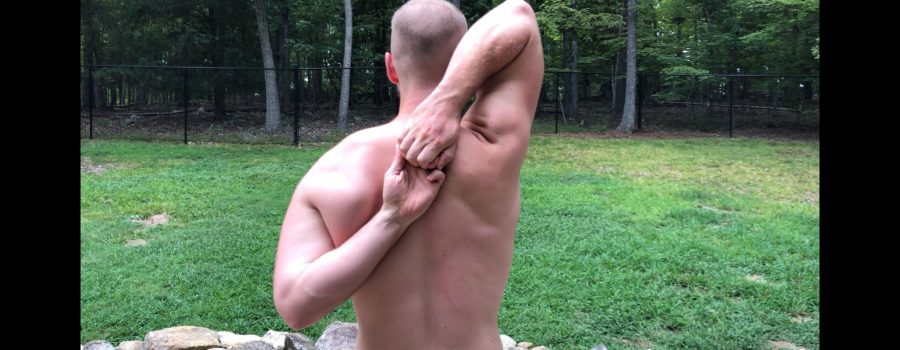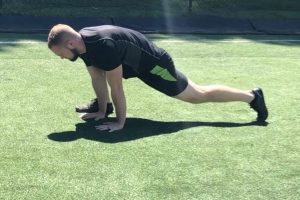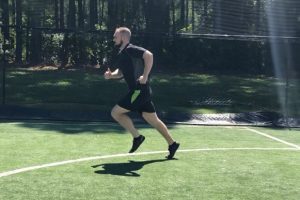Have Shoulder Problems? Make sure you are working on these 5 important factors!
The shoulder is an amazing joint – it’s the most mobile joint in the body and it connects the arm to the torso. But these two factors also can create a situation where a lack of controlled mobility can lead to a higher likelihood of injury. Dislocations, separations, rotator cuff tears, and impingement can all hinder our ability to use this joint effectively.
Further Learning: Check out this podcast I did with Physical Therapist Marvin Jacob on the shoulder joint!
Unfortunately, I speak from experience. I dislocated my shoulder badly in college in a fall that left me without much stability in the joint. Over the following years, my shoulder dislocated another 10 times, forcing me to step back to figure out a better way of managing the pain and loss of confidence in doing anything with the upper body that I experienced as a result.
One issue that commonly leads many people to have a higher recurrence of injury in the shoulder joint is the lack of a comprehensive training and rehabilitation model for those suffering from shoulder problems. Most physical therapists will put you through a bare minimum of shoulder workouts that include band movements and passive range of motion exercises but do not extend the difficulty of training much past that.
As I learned from personal experience, this baseline of understanding and training just does not cover it when it comes to having a recovery program that can actually prevent future injury, not just getting you out of pain.
Oftentimes an injury we experience can seem sudden and surprising without prior warning signs. However, this is rarely the case. Most acute injuries happen after years of sub-par movement quality, tightness, stiffness, and weakness. For example, my first dislocation was surprising, but looking back I can see how my poor side sleeping habits, over reliance on barbell bench presses, lack of pulling exercise volume, and limited training modality and exercise selection played a big part in creating an unhealthy and imbalanced shoulder joint.
Now I’m not saying that all acute injuries happen from bad movement – sometimes you can get hit by a car and have significant problems! But I am saying that the rotator cuff tear or frozen shoulder you experience that seems to come out of nowhere is oftentimes a problem built off of years of poor movement and weakness.
So in an effort to fix that, I’ve taken my years of shoulder experiments and have distilled them down to a best practices program for training and building strong and healthy shoulders. I’ll have more information for you later on if you’re interested, but for now let’s do a brief overview on the 5 areas that play into shoulder health that you may not have thought of before!
1) The ribcage/spine/pelvis – Before we even look upwards at the shoulder and upper torso, we have to make sure we can create a solid foundation to move off of. This is essential because the scapula and shoulders move relative to the torso. If that isn’t fixed and your rib cage is flaring up, you will end up compensating for poor shoulder mobility by moving your spine and not even realizing it.
This all plays into the skill of being able to brace your core/spine. The simple way to accomplish this is to exhale and squeeze your abdominals as though someone is going to punch you in the gut. You’ll notice that the spine and pelvis return to a neutral position once you do this. This creates the solid foundation that you move the scapula off of to put the shoulder in the correct anatomical posture for movement!
It doesn’t matter how tall or strong a building is if the foundation is not capable to supporting the structure! By setting the pelvic floor and rib cage we set the foundation of the upper body and then can train the muscles and joints from a proper position!
2) The Scapula – This is a flat bone that glides over the upper torso and rib cage. Though it may seem like an obvious player in the shoulder joint given that it is part of the bone that composes the anatomical structure, what people generally don’t understand is how important this bone is for the shoulder.
First, this bone serves as the attachment point for the majority of the major mover muscles in the shoulder joint like the lats, the biceps, the triceps, and the traps. Second, the scapula helps to set the shoulder joint by creating the proper posture and fit of the arm bone into the shoulder socket.
Without a solid base of strength with the mid and upper traps, we tend to get protracted and elevated in our posture. This means we start to look like hunched over cavemen with the rounded upper back and poor movement at the joint! Simply put – when in doubt, pull the shoulder blades down and back!
3) The Neck – The next big player in the shoulder complex is the neck. I know, you may think of the neck as an entirely separate joint without much relation, but it plays so much more into your shoulder and upper back stiffness than you might think. This is because your head is really heavy. I mean, my head is too so don’t take offense, but that’s not the point. What I’m getting at here is that our neck and upper back muscles have to work really hard to keep the head stable. And the further forward we tilt our head, the more these muscles have to strain.
When we sit upright and pull our head back to an anatomically proper position our head is stacked over the spine in a way that maximizes stability without excessive muscle activation. But when we aren’t mindful of that and walk around with poor posture and a forward, jutted neck, this isn’t the case. Our spine is naturally curved, and since we tend to always look forward and down at the ground or at our phone, we end up putting a lot of stress and strain on this structure.
Training for the neck can be a huge help for the shoulder simply because without good posture or a solid level of control we eventually just run out of bandwidth to stabilize it all. This means that we leverage the upper back and traps to keep our neck supported instead of prioritizing good movement at the shoulders! Challenging your neck flexion and extension can change this!
4) The Arms, Grip, and Wrist – The wrist, elbow, and the muscles of the arms are all affected by the position of the shoulder. Conversely, the position of the wrist, elbow, and muscles of the arm all affect the position of the shoulder, causing a two-way scenario where both are important and inextricably related. We need to focus on both aspects as part of fixing your overall shoulder position and posture.
These joints are a great example of the fact that most pain and problems are caused by a joint upstream or downstream to the joint that you feel the pain in. If you’re in a bad caveman posture with your hands rotated in, shoulders slumped forward, head hanging down, this places the elbow and wrist in a poor position. Overuse injuries like tennis elbow, golfer’s elbow, or carpal tunnel syndrome are caused by an upstream problem due to poor shoulder/scapular position.
The big solution here is to increase the diversity of movement selection, grip placement, and modality/equipment use. Instead of doing barbell bench press in the same grip and position every time, switch things up! Do a neutral grip dumbbell press or some chin ups for example.
5) The Rotator Cuff – So now we’re going to talk about the shoulder joint in isolation. From a stability perspective, there are 4 muscles that are charged with keeping your shoulder in a safe and stable place. These muscles are collectively called the rotator cuff. Essentially, they come from different angles to wrap around the head of the shoulder to hold the bone in the ideal position in the joint.
A big mistake people make is in relying on the big mover muscles for stability, like the pecs, lats, and traps, instead of improving the strength and control of the actual stabilizer muscles. But to do this correctly we have to start small with simple unloaded exercises before moving to more diverse training methods like throwing, crawling, hanging, and swinging.
This is often the shortcoming of most rehabilitative efforts – a lot of emphasis on the small banded movements but not enough focus on progressing that training to really regain strength and capacity. Ultimately this leaves our problems half solved, which does no one any good.
But the good news for you is that you can continue to improve your strength and stability! And if that is something you’re interested in, then I have exactly what you are looking for. What I just covered was a brief overview of the curriculum in my latest product – The Strong Shoulders Series.
This is an in depth look at every factor that goes into training and anatomical consideration of the shoulder. I have a complete video series that walks you through the process as well as a written transcription/PDF of the information. BUT that’s only half of the battle! No shoulder program would be complete without actual work to implement and do yourself.
Included in the product is a three-phase program with all exercises, reps, and sets, that you’ll need to confidently train for better shoulders!
I have a risk free, money back guarantee so you have absolutely nothing to lose. If you’re tired of dealing with instability, fear, and pain in your shoulders, now is the time to actually DO something about it!
Check it out here to learn more and get signed up: https://grahamtuttle.mykajabi.com/offers/BqbD3YRa




